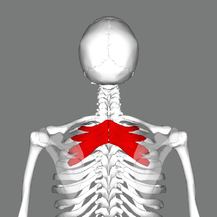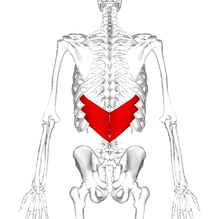Serratus Posterior: Difference between revisions
No edit summary |
No edit summary |
||
| Line 1: | Line 1: | ||
<div class="editorbox"> | <div class="editorbox"> | ||
'''Original Editor '''- | '''Original Editor '''- [[User:User Name|Khloud Shreif]] | ||
'''Top Contributors''' - {{Special:Contributors/{{FULLPAGENAME}}}} | '''Top Contributors''' - {{Special:Contributors/{{FULLPAGENAME}}}} | ||
Revision as of 00:48, 12 March 2020
Original Editor - Khloud Shreif
Top Contributors - Khloud Shreif, Kim Jackson and Ahmed M Diab
Description[edit | edit source]
Serratus posterior muscle consists of serratus posterior superior and serratus posterior inferior they are intermediate layer of back muscles
Origin[edit | edit source]
Serratus posterior superior: C7-T3 vertebrae spinous process and nuchal ligament
Serratus posterior inferior: T11-L2 vertebrae spinous process
Insertion[edit | edit source]
It inserts into ribs
Serratus posterior superior: at upper border of 2nd-5th ribs
Serratus posterior inferior: at lower border of 9th-12th ribs
Nerve[edit | edit source]
Serratus posterior superior innervated by ventral rami of intercoastal nerves of T1-T5.
Serratus posterior inferior innervated by ventral rami of intercoastal nerves of T9-T12.
Function[edit | edit source]
Both serratus posterior superior and inferior are accessory muscles for respiration, but their is no electromyographic evidence support it's respiratory role[1].
Serratus posterior superior: elevate the ribs during inspiration(accessory muscle of inspiration) and has a stabilization role for thorax.
Serratus posterior inferior: depress the ribs during expiration(accessory muscle of expiration)
Bilateral action of posterior superior/posterior inferior reduce extension of thoracic vertebrae.
Unilateral action: rotate spine to opposite side.
Clinical relevance[edit | edit source]
Serratus posterior superior and serratus posterior inferior especially serratus posterior superior may participate and cause myofascial pain syndrome and it's referred pattern can be overlapped with other muscles as it lies deeper.This referred pain start from back of shoulder runs to elbow and ulnar side of wrist.[2] Serratus posterior inferior pain is localized don't have referred pattern.
Another contribution to serratus posterior superior muscle due to improper posture or inappropriate use of muscle for example holding phone between ear and shoulder that cause scapulocostal syndrome and may be misdiagnosed with the lesion of spinal nerves of cervical spine.[3]
Treatment[edit | edit source]
We can't palpate this muscle as it lies under trapezius, rhomboids, back muscles and others and to better exposure of SPS muscle we need to take shoulder blade out.
Resources[edit | edit source]
www.visiblebody.com.muscle anatomy serratus posterior superior and inferior
www.kenhub.com. en library anatomy serratus posterior muscles
For referral pattern and self message and trigger point release for serratus posterior muscle www.muscle-joint-pain.com trigger point self treatment serratus posterior superior.
References[edit | edit source]
- ↑ Loukas M, Louis RG, Wartmann CT, Tubbs RS, Gupta AA, Apaydin N, Jordan R. An anatomic investigation of the serratus posterior superior and serratus posterior inferior muscles. Surgical and Radiologic Anatomy. 2008 Mar 1;30(2):119-23.
- ↑ Vilensky JA, Baltes M, Weikel L, Fortin JD, Fourie LJ. Serratus posterior muscles: anatomy, clinical relevance, and function. Clinical Anatomy: The Official Journal of the American Association of Clinical Anatomists and the British Association of Clinical Anatomists. 2001 Jul;14(4):237-41.
- ↑ Fourie LJ. The scapulocostal syndrome. South African Medical Journal. 1991;79(6):721-4.
- ↑ Richard Finn. Serratus Posterior Superior Richard Finn LMT, CMTPT, MCSTT. Available from: http://www.youtube.com/watch?v=HTbSxooHIRc[last accessed 12/3/2020]








